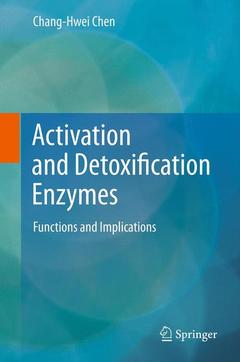Description
Activation and Detoxification Enzymes, 2012
Functions and Implications
Author: Chen Chang-Hwei
Language: English
Subjects for Activation and Detoxification Enzymes:
Keywords
Approximative price 116.04 €
In Print (Delivery period: 15 days).
Add to cartPublication date: 01-2014
182 p. · 15.5x23.5 cm · Paperback
Approximative price 158.24 €
In Print (Delivery period: 15 days).
Add to cartPublication date: 11-2011
182 p. · 15.5x23.5 cm · Hardback
Description
/li>Contents
/li>Comment
/li>
Humans are exposed to foreign compounds such as drugs, household products and environmental chemicals by swallowing or breathing. Also, food is considered a foreign compound. Such foreign compounds can be non-essential and non-functional to life, and commonly are referred to as xenobiotics. Some xenobiotics are not toxic; however, many of them are potentially toxic or become toxic after conversion to metabolic intermediates. A considerable number of foreign compounds belong to non-polar, lipophilic substances. Lipophilic compounds are not soluble in water. Metabolic conversion of lipophilic foreign compounds to facilitate their removal from the body is essentially carried out by biochemical reactions catalyzed by two classes of metabolizing enzymes, namely, activation enzymes and detoxification enzymes.
Activation enzyme-catalyzed functionalization reaction introduces a functional group to a lipophilic compound. Functionalization modifies many foreign compounds to form reactive intermediates capable of interacting with cellular components (proteins, DNA and lipids), leading to a variety of conditions for diseases. Functionalized compounds are further metabolized through detoxification enzyme-catalyzed reactions, which result in an increase in the solubility of parent compounds and an inactivation of metabolic intermediates, thus facilitating their excretion from the body. To minimize the exposure of potentially toxic metabolic intermediates, it is essential to keep them at a minimum level.
Extensive investigations have revealed that foreign compound-metabolizing enzymes exhibit genetic polymorphisms. Variations in their activities can produce different results as to the susceptibility to potential toxic effects. Moreover, the expressions of activation enzymes and detoxification enzymes are inducible. A number of chemical compounds are capable of acting as modulators for these two classes of enzymes. These findings have lead to the proposal of modulating metabolizing enzymes as a useful approach for human health benefits. Importantly, many of these chemical compounds are present in human daily diets.
There are many advances that have been made in the past decades towards the understanding of functions and implications of activation enzymes and detoxification enzymes. An organized, concise overview is needed for the readers who are initially exposed to this important subject, particularly for students and researchers in the areas of biomedical sciences, biochemistry, nutrition, pharmacology and chemistry. This book is intended to serve this purpose as an introduction to the subject. Furthermore, major topics in the book, excluding catalytic reactions and structural properties, may have interest to other readers who have knowledge of basic sciences and understanding enzyme related information.
The book discusses subjects associated with foreign compound metabolizing enzymes with emphasis on biochemical aspects, including lipophilic foreign compounds, catalytic properties, reactive intermediates, biomedical and biochemical effects, genetic polymorphisms, enzyme inducibility, enzyme modulation for health benefits, dietary related enzyme modulators, and structural characteristics of enzyme inducers.
Overview.- Lipophilic Foreign Compounds.- Metabolic Conversion of Lipophilic Compounds.- Phase I Enzymes.- Phase II Enzymes.- Reactive Intermediate Formation.- Biomedical and Biochemical Effects.- Genetic Variations in Metabolizing Enzymes.- Inducibility of Metabolizing Enzymes.- Induction and Inhibition Compounds.- Diets Rich in Enzyme Modulators.- Induction of Enzymes for Health Benefits.- Sources of Foreign Compounds.- Catalytic Reactions of Phase I Enzymes.- Catalytic Reactions of Phase II Enzymes.- Diversified Classes of Enzyme Modulators.- Conclusion.- Index.
Incorporates cutting-edge research
Features chapters written by renowned experts
Contains helpful, full-color figures
Includes supplementary material: sn.pub/extras




